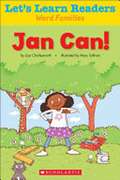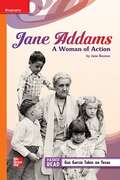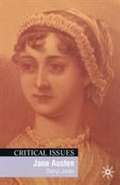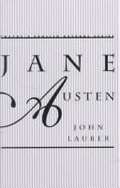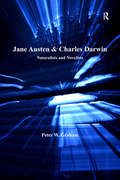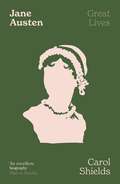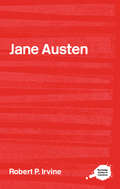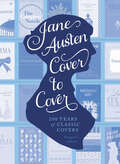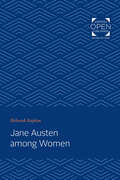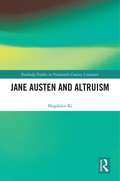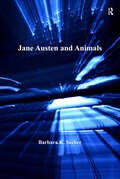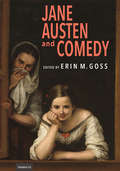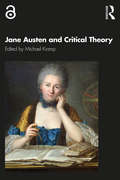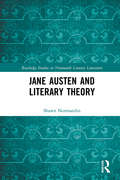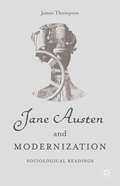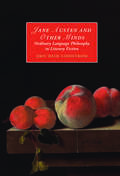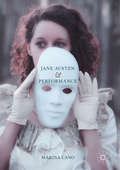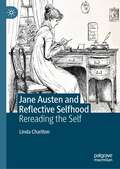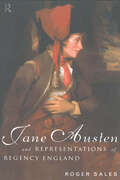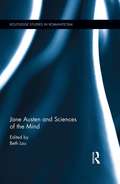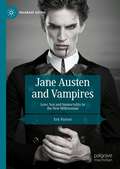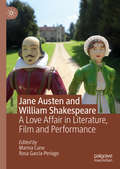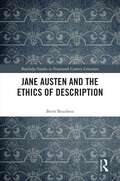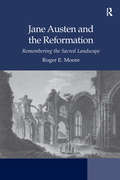- Table View
- List View
Jan Can! (Word Family Readers)
by Liza CharlesworthLet's Learn Readers boost key literacy skills through engaging, easy-to-read stories. Jump-start phonics learning with these super-fun books! For use with Grades K-2.
Jane Austen
by Darryl JonesThis book offers a one-volume study of Jane Austen that is both a sophisticated critical introduction and a valuable contribution to the study of one of the most popular and enduring British novelists. Darryl Jones provides students with a coherent overview of Austen's work and an idea of the current state of critical debate.
Jane Austen
by John LauberLauber illuminates for general readers and students new to her work each of the six novels Austen (1775-1817) completed--Sense and Sensibility, Pride and Prejudice, Mansfield Park, Emma, Persuasion, and Northanger Abbey--as well as her two unfinished novels and juvenilia. Annotation c. by Book News, Inc., Portland, Or.
Jane Austen
by Tony TannerBiography that attempts to see the Austen novels in their relation to problems concerned with society, education and language.
Jane Austen & Charles Darwin: Naturalists and Novelists (The\nineteenth Century Ser.)
by Peter W. GrahamAre Jane Austen and Charles Darwin the two great English empiricists of the nineteenth century? Peter W. Graham poses this question as he brings these two icons of nineteenth-century British culture into intellectual conversation in his provocative new book. Graham shows that while the one is generally termed a naturalist (Darwin's preferred term for himself) and the other a novelist, these characterizations are at least partially interchangeable, as each author possessed skills that would serve well in either arena. Both Austen and Darwin are naturalists who look with a sharp, cold eye at the concrete particulars of the world around them. Both are in certain senses novelists who weave densely particularized and convincingly grounded narratives that convey their personal observations and perceptions to wide readerships. When taken seriously, the words and works of Austen and Darwin encourage their readers to look closely at the social and natural worlds around them and form opinions based on individual judgment rather than on transmitted opinion. Graham's four interlocked essays begin by situating Austen and Darwin in the English empirical tradition and focusing on the uncanny similarities in the two writers' respective circumstances and preoccupations. Both Austen and Darwin were fascinated by sibling relations. Both were acute observers and analysts of courtship rituals. Both understood constant change as the way of the world, whether the microcosm under consideration is geological, biological, social, or literary. Both grasped the importance of scale in making observations. Both discerned the connection between minute, particular causes and vast, general effects. Employing the trenchant analytical talents associated with his subjects and informed by a wealth of historical and biographical detail and the best of recent work by historians of science, Graham has given us a new entree into Austen's and Darwin's writings.
Jane Austen (LIVES #6)
by Carol ShieldsBestselling, award-winning novelist writing about one of the most popular and enduring English novelists of all time.'Splendid ... a gem' LITERARY REVIEW'An excellent biography' MAIL ON SUNDAY'Shields on Austen offers up a delicious prospect. And we are not disappointed' SCOTSMANJane Austen was one of the world's most remarkable writers, whose characters are as alive today as they were two hundred years ago. Despite being one of the most perceptive writers about people and relationships, she never married and always lived with her parents and sister Cassandra.Perhaps unusual for women at that time, Jane Austen was acutely aware of the larger political and social world around her, but chose to focus her novels on the family as a microcosm through which to explore human nature.The prizewinning novelist Carol Shields gives us a beautifully written, perceptive look at the life of one of the finest and most popular English novelists of all time.
Jane Austen (Routledge Guides to Literature)
by Robert P. IrvineJane Austen is one of England's most enduringly popular authors, renowned for her subtle observations of the provincial middle classes of late eighteenth- and early nineteenth-century England.This guide to Austen's much-loved work offers: an accessible introduction to the contexts and many interpretations of Austen's texts, including film adaptations, from publication to the present an introduction to key critical texts and perspectives on Austen's life and work, situated within a broader critical history cross-references between sections of the guide, in order to suggest links between texts, contexts and criticism suggestions for further reading. Part of the Routledge Guides to Literature series, this volume is essential reading for all those beginning detailed study of Jane Austen and seeking not only a guide to her works but also a way through the wealth of contextual and critical material that surrounds them.
Jane Austen Cover to Cover: 200 Years of Classic Book Covers
by Margaret C. SullivanJane Austen's six novels are true classics, still immensely popular some 200 years after their first publication. But although the celebrated stories never change, the covers are always different. Jane Austen Cover to Cover compiles two centuries of design, from elegant Victorian hardcovers and the famed 1894 "Peacock" edition to 1950s pulp, movie tie-in editions, graphic novels, foreign-language translations, and many, many others. Filled with beautiful artwork and insightful commentary, this fascinating and visually intriguing collection is a must for Janeites, design geeks, and book lovers of every stripe.
Jane Austen among Women
by Deborah KaplanOriginally published in 1992. In an age when genteel women wrote little more than personal letters, how did Jane Austen manage to become a novelist? Was she an isolated genius who rose to fame through sheer talent? Did she draw strength from the support of her family or from women writers who went before her? In Jane Austen among Women, Deborah Kaplan argues that these explanations are either misleading or insufficient. Austen, Kaplan contends, participated actively in a women's culture that promoted female authority and achievement—a culture that not only helped her become a novelist but also influenced her fiction.
Jane Austen and Altruism (Routledge Studies in Nineteenth Century Literature)
by Magdalen KiJane Austen and Altruism identifies a compelling theme, namely, the view that Jane Austen propounds a rigorous, boundary-sensitive model of altruism that counters the human propensity to selfishness and promotes the culture of cooperation. In her days, altruism was commonly known as "benevolence", "charity," or "philanthropy", and these concepts overlap with Auguste Comte’s later definition of altruism as "otherism". This volume argues that Austen’s thinking co-opts the evolutionary idea that altruism is seldom truly pure, egoism cannot be eradicated, and boundless group altruism is not sustainable. However, given that she comes from a naval and clergy family, she witnesses the power of wartime patriotism, the Evangelical revival, the Regency culture of politeness, and the sentimental novels. In her novels, she locates human relationships along an altruism continuum that ranges from enlightened selfishness to pathological altruism. Unconditional love is hard to find, but empathy, kin altruism, reciprocal exchange, and group altruism are key to the formation of self-identity, family, community and the nation state.
Jane Austen and Animals
by Barbara K. SeeberThe first full-length study of animals in Jane Austen, Barbara K. Seeber’s book situates the author’s work within the serious debates about human-animal relations that began in the eighteenth century and continued into Austen’s lifetime. Seeber shows that Austen’s writings consistently align the objectification of nature with that of women and that Austen associates the hunting, shooting, racing, and consuming of animals with the domination of women. Austen’s complicated depictions of the use and abuse of nature also challenge postcolonial readings that interpret, for example, Fanny Price’s rejoicing in nature as a celebration of England’s imperial power. In Austen, hunting and the owning of animals are markers of station and a prerogative of power over others, while her representation of the hierarchy of food, where meat occupies top position, is identified with a human-nature dualism that objectifies not only nature, but also the women who are expected to serve food to men. In placing Austen’s texts in the context of animal-rights arguments that arose in the late eighteenth and early nineteenth centuries, Seeber expands our understanding of Austen’s participation in significant societal concerns and makes an important contribution to animal, gender, food, and empire studies in the nineteenth century.
Jane Austen and Comedy (Transits: Literature, Thought & Culture 1650-1850)
by Erin GossJane Austen and Comedy takes for granted two related notions. First, Jane Austen’s books are funny; they induce laughter, and that laughter is worth attending to for a variety of reasons. Second, Jane Austen’s books are comedies, understandable both through the generic form that ends in marriage after the potential hilarity of romantic adversity and through a more general promise of wish fulfillment. In bringing together Austen and comedy, which are both often dismissed as superfluous or irrelevant to a contemporary world, this collection of essays directs attention to the ways we laugh, the ways that Austen may make us do so, and the ways that our laughter is conditioned by the form in which Austen writes: comedy. Jane Austen and Comedy invites reflection not only on her inclusion of laughter and humor, the comic, jokes, wit, and all the other topics that can so readily be grouped under the broad umbrella that is comedy, but also on the idea or form of comedy itself, and on the way that this form may govern our thinking about many things outside the realm of Austen’s work. Published by Bucknell University Press. Distributed worldwide by Rutgers University Press.
Jane Austen and Critical Theory
by Michael KrampJane Austen and Critical Theory is a collection of new essays that addresses the absence of critical theory in Austen studies—an absence that has limited the reach of Austen criticism. The collection brings together innovative scholars who ask new and challenging questions about the efficacy of Austen’s work. This volume confronts mythical understandings of Austen as "Dear Aunt Jane," the early twentieth-century legacy of Austen as a cultural salve, and the persistent habit of reading her works for advice or instruction. The authors pursue a diversity of methods, encourage us to build new kinds of relationships to Austen and her writings, and demonstrate how these relationships might generate new ideas and possibilities—ideas and possibilities that promise to expand the ways in which we deploy Austen. The book specifically reminds us of the vital importance of Austen and her fiction for central concerns of the humanities, including the place of the individual within civil society, the potential for new identities and communities, the urgency to address racial and sexual oppression, and the need to imagine more just futures.
Jane Austen and Literary Theory (Routledge Studies in Nineteenth Century Literature)
by Shawn NormandinJane Austen was one of the most adventurous thinkers of the late eighteenth and early nineteenth centuries, but one would probably never guess that by reading her critics. Perhaps no canonical author in English literature has proven, until now, more resistant to theory. Tracing the political motives for this resistance, Jane Austen and Literary Theory proceeds to counteract it. The book’s detailed interpretations guide readers through some of the important intellectual achievements of Austen’s career—from the stunning teenage parodies "Evelyn" and "The History of England" to her most accomplished novels, Pride and Prejudice, Mansfield Park, and Emma. While criticism has largely been content to describe the various ways Austen was a product of her time, Jane Austen and Literary Theory reveals how she anticipated the ideas of formidable literary thinkers of the twentieth century, especially Jacques Derrida and Paul de Man. Gift and exchange, speech and writing, symbol and allegory, stable irony and Romantic irony—these are just a few of the binary oppositions her dazzling texts deconstruct. Although her novels are major achievements of nineteenth-century realism, critics have hitherto underestimated their rhetorical cunning and their fascination with the materiality of language. Doing justice to Austen’s language requires critical methods as ruthless as her irony, and Jane Austen and Literary Theory supplies these methods. This book will enable both her devotees and her detractors to appreciate her genius in unusual ways.
Jane Austen and Modernization
by James ThompsonJane Austen wrote when sociology was being established as the new discipline to understand social issues such as urbanization and industrialization. Drawing on landmark sociologists such as Durkheim and Bourdieu, this study argues that the novels of Austen were heavily influenced by these early developments in sociology.
Jane Austen and Other Minds: Ordinary Language Philosophy in Literary Fiction (Cambridge Studies in Romanticism #136)
by Eric Reid LindstromJane Austen's fiction is itself philosophy, a fact to which Stanley Cavell attested when he honored his philosophical teacher, J. L. Austin, through homage to her and her work. Engaging equally in criticism and in philosophy, Jane Austen and Other Minds demonstrates the standing of Austen's fiction as a philosophical investigation, both in its own right and as a resource to ordinary language philosophy in the twentieth and twenty-first centuries. Eric Reid Lindstrom addresses a long-standing shortcoming of Austen scholarship by locating in her fiction a linguistic phenomenology available to the novelistic everyday but not afforded her in intellectual history. He simultaneously advances recognition and understanding of J. L. Austin and Stanley Cavell, and of ordinary language philosophy, within Austen scholarship and the broader field of contemporary literary studies. This book argues compellingly for Cavell's choice of Austen as a means to pursue 'passionate exchange,' reimagining her common association with restriction and confinement.
Jane Austen and Performance
by Marina CanoThis is the first exploration of the performative and theatrical force of Austen's work and its afterlife, from the nineteenth century to the present. It unearths new and little-known Austen materials: from suffragette novels and pageants to school and amateur theatricals, passing through mid-twentieth-century representations in Scotland and America. The book concludes with an examination of Austen fandom based on an online survey conducted by the author, which elicited over 300 responses from fans across the globe. Through the lens of performative theory, this volume explores how Austen, her work and its afterlives, have aided the formation of collective and personal identity; how they have helped bring people together across the generations; and how they have had key psychological, pedagogical and therapeutic functions for an ever growing audience. Ultimately, this book explains why Austen remains the most beloved author in English Literature.
Jane Austen and Reflective Selfhood: Rereading the Self
by Linda CharltonThis book makes connections between selfhood, reading practice and moral judgment which propose fresh insights into Austen’s narrative style and offer new ways of reading her work. It grounds her writing in the Enlightenment philosophy of selfhood, exploring how Austen takes five major components of selfhood theory—memory, imagination, probability, sympathy and reflection—and investigates their relation to self-formation and moral judgement. At the same time, Austen’s narrative style breaks new ground in the representation of consciousness and engages directly with contemporary concerns about reading practice. Drawing analogies between reading text and reading character, the book argues that Austen’s rendering of reading and rereading as both reflective and constitutive acts demonstrates their capacity to enable self-recognition and self-formation. It shows how Austen raises questions about the potential for different readings and, in so doing, challenges her readers to reflect on and reread their own interactions with her texts.
Jane Austen and Representations of Regency England
by Roger SalesIn Jane Austen and Representations of Regency England, Roger Sales looks at Jane Austen's entire oeuve, and views her historically as a Regency writer voicing concerns on the condition of England. Examining Austen's literary works; her letters - in the context of those of other Regency women; as well as contemporary texts such as television adaptations of her work, Jane Austen and Representations of Regency England reconstructs the breadth of Jane Austen's writing. It also examines: * her representations of dandyism and masculine identities * the events of the Regency crisis of 1810-12 * the way in which Austen engaged in topical debates such as healthcare in both Emma and Persuasion.
Jane Austen and Sciences of the Mind (Routledge Studies in Romanticism)
by Beth LauThe essays in this volume interpret Jane Austen’s fiction through the lens of various sciences of the mind and brain, especially the cluster of disciplines implicated in the term cognitive science, including neuroscience, evolutionary biology, evolutionary and developmental psychology, and others. The field of cognitive literary studies has rapidly developed in the last few decades and achieved the status of an established (if still evolving) critical approach. One of the most popular authors to analyze from this perspective is Jane Austen. As numerous critics have noted, Austen was a keen observer of how the mind operates in its interactions with other minds, both when it functions successfully and when, as often happens, it goes awry, and her perceptions are often in synch with current neuroscientific and psychological research. Despite the widespread recognition of the special congruity between Austen’s novels and cognitive science, however, no book has been devoted to this subject. Jane Austen and Sciences of the Mind is the first monograph wholly comprised of readings of Austen’s oeuvre (juvenilia as well as all six completed novels) from cognitive and related psychological approaches. In addition, the volume operates under the assumption that cognitive and historicist approaches are compatible, and many essays situate Austen within the climate of ideas during her era as well as in relation to current research in the sciences and social sciences. Jane Austen and Sciences of the Mind offers a new lens for understanding and illuminating the concerns, techniques, and enduring appeal of Austen’s novels.
Jane Austen and Vampires: Love, Sex and Immortality in the New Millennium (Palgrave Gothic)
by Eric ParisotJane Austen and Vampires is the first book to investigate the literary convergence of Jane Austen and vampires in Austen fanfic after the success of Stephenie Meyer’s Twilight (2005) and Seth Grahame-Smith’s Pride and Prejudice and Zombies (2009). It asks how the shifting cultural values of Austen and the vampire have aligned, and what their connection might mean for their respective contemporary legacies. It also makes a case for reading “low brow” Austen fanfic attentively, as a way to gain meaningful insight directly from Austen fans into the tensions and anxieties surrounding contemporary notions of love, sex, femininity, and Austen’s modern currency. Offering close readings of Austen’s vampire-slaying heroines, vampiric retellings of Pride and Prejudice, and the transformation of Austen herself into a vampire, this book reveals Austen-vampire mashups as messy, complex entanglements that creatively and self-reflexively interrogate modern fantasies of vampire romance. By its unique intersection of Jane Austen with the vampire, the Gothic, fan culture and popular romance, Jane Austen and Vampires adds a new chapter to the history of Austen’s reception, for fans, students and scholars alike.
Jane Austen and William Shakespeare: A Love Affair in Literature, Film and Performance
by Marina Cano Rosa García-PeriagoThis volume explores the multiple connections between the two most canonical authors in English, Jane Austen and William Shakespeare. The collection reflects on the historical, literary, critical and filmic links between the authors and their fates. Considering the implications of the popular cult of Austen and Shakespeare, the essays are interdisciplinary and comparative: ranging from Austen’s and Shakespeare’s biographies to their presence in the modern vampire saga Twilight, passing by Shakespearean echoes in Austen’s novels and the authors’ afterlives on the improv stage, in wartime cinema, modern biopics and crime fiction. The volume concludes with an account of the Exhibition “Will & Jane” at the Folger Shakespeare Library, which literally brought the two authors together in the autumn of 2016. Collectively, the essays mark and celebrate what we have called the long-standing “love affair” between William Shakespeare and Jane Austen—over 200 years and counting.
Jane Austen and the Ethics of Description (Routledge Studies in Nineteenth Century Literature)
by Brett BourbonJane Austen and the Ethics of Description demonstrates that Elizabeth Bennet and her creator are misunderstood, and often unrecognized, geniuses of moral philosophy, but not simply because of their virtue or wit or natural skills in game theory. The engine driving the moral judgement and growth of Austen’s protagonists consists of a particular and not well-understood ability to reason by description, a skill which we moderns must recover and remaster in order to negotiate the complexities of contemporary life. The forms of rational description this volume derives from Austen will be of great interest to not only literary critics and theorists, but also to philosophers and anyone interested in ethics, the dynamics of power, and practical reasoning. Written in a clear style, the book is for those who love Austen and for those who want to understand how we should reason about our lives. The book is written for those who love Austen, of course, but also for those who are interested in questions about how to live and in fundamental and practical questions about power, social conflict, self-awareness, and practical reasoning. It is a literary analysis, a philosophical argument, and a practical guide to ethical thinking.
Jane Austen and the Reformation: Remembering the Sacred Landscape
by Roger Emerson MooreJane Austen's England was littered with remnants of medieval religion. From her schooling in the gatehouse of Reading Abbey to her visits to cousins at Stoneleigh Abbey, Austen faced constant reminders of the wrenching religious upheaval that reordered the English landscape just 250 years before her birth. Drawing attention to the medieval churches and abbeys that appear frequently in her novels, Moore argues that Austen's interest in and representation of these spaces align her with a long tradition of nostalgia for the monasteries that had anchored English life for centuries until the Reformation. Converted monasteries serve as homes for the Tilneys in Northanger Abbey and Mr. Knightley in Emma, and the ruins of the 'Abbeyland' have a prominent place in Sense and Sensibility. However, these and other formerly sacred spaces are not merely picturesque backgrounds, but tangible reminders of the past whose alteration is a source of regret and disappointment. Moore uncovers a pattern of critique and commentary throughout Austen's works, but he focuses in particular on Northanger Abbey, Mansfield Park, and Sanditon. His juxtaposition of Austen's novels with sixteenth- and seventeenth-century texts rarely acknowledged as relevant to her fiction enlarges our understanding of Austen as a commentator on historical and religious events and places her firmly in the long national conversation about the meaning and consequences of the Reformation.
